When Microsoft first announced the Surface tablets back in June 2012 they didn’t reveal much about the Surface Pro other than it would run an Intel processor and launch 90 days after the RT version launched on October 26. It wasn’t until November that Microsoft provided more info on price and hardware specifications. Last weekend I was lucky enough to pick up a retail version. Here’s my review.
Surface Pro Specifications
- Core i5 processor @ 1.7GHz
- 4GB RAM
- 10.6″ 9 ClearType with 1920×1080 full HD resolution
- Full digitizer and ink support with Palm Block technology
- Full-size USB 3.0 port
- Bluetooth 4.0
- Wi-Fi 802.11a/b/g/n
- Mini DisplayPort (displays up to 2560 x 1440 resolution)
- microSDXC card slot
- Weight: 907gm / 2lb
There are two versions, a 64GB version @ $899 and a 128GB version selling for $999.
More details, links and videos in the Ultrabooknews Surface Pro information page.
Build, Ports, Ergonomics
We’re talking about a pure Windows 8 tablet here running on a capable processor and including a digitizer layer. As a fully-capable Windows tablet it’s light. The Surface Pro is similar in style to the Surface RT but is heavier at 2lbs and a few millimetres taller. Build quality follows the high standard set by the RT but just feels more substantial. It has the same VaporMg casing but adds what Microsoft calls perimeter venting all along the rear edge. The signature kickstand is present and supports the tablet firmly and with it extended the tablet sits square on a flat surface with no discernible imbalance. Overall it feels good and surprisingly compact in the hand but the weight means it becomes uncomfortable to hold for a long period of time, how much though will very for each individual.

Don’t expect a full complement of ports but Microsoft have done well considering the space limitations. USB3.0 and DisplayPort offer the best data and video output possibilities but there’s only a single USB3.0 port. A MicroSDXC port enables storage expansion but isn’t much good for swapping data between devices. A ‘cover’ port (for the keyboard), headset port and power port complete the line-up.
Screen
The FullHD (1920×1080) screen is clear and crisp with very good viewing angles vertically and horizontally and at maximum brightness is extremely bright; colours look vibrant with good black levels. It feels very smooth to the touch and responds to taps and swipes with no issues. It also responds well to the pen input when used for note taking and the palm rejection works as expected.
The pen itself is sized like a regular pen so is comfortable to hold though its made of glossy plastic which may make it slippery under certain conditions. It has a magnetic attachment on the side which clicks into the power charging port while doubling as a button.
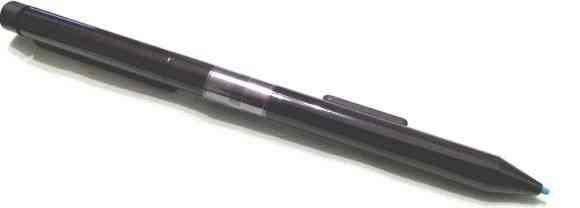
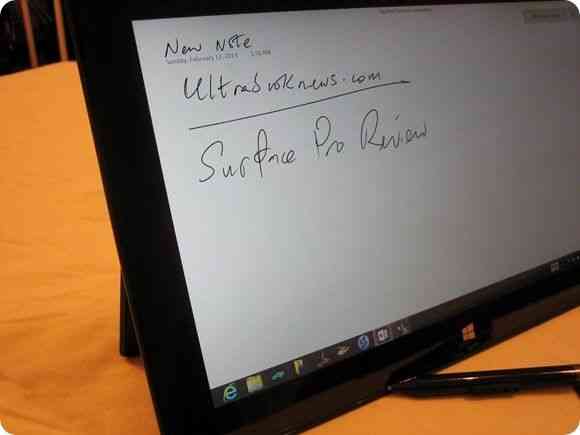
Performance – Benchmarks, real world
In use the Surface Pro deals with normal computing tasks with no complaints thanks to its Core i5 CPU and 4GB of RAM. Programs open swiftly, browser pages load fast and generally navigating through the OS feels snappy with instant responses to input whether in the desktop or the Modern UI. Though the HD4000 is not the last word in gaming it can handle games from the Windows store with no problem, though it takes a heavy toll on battery life and generates enough heat to get the fans going, which are noticeable under heavy load but silent during normal use. The loudest I have heard the fans was when running the hardware benchmarks when it got really loud but unless you are stressing the unit constantly it wont be a problem.
Hardware used for Wi-Fi is a Marvell AVASTAR 350N Wireless Controller rather than an Intel controller so WiDi is not supported. The connection though is stable and streams multimedia ok though the signal strength displayed by the status icon shows fewer bars than other devices used in the same area. So far there have been no issues with dropped or limited connections.
One issue that I noticed with the HD screen was that when watching YouTube videos full screen the controls were extremely small and became difficult to hit as a result.
Surface Pro Performance Tests
The tests were carried out with the Surface plugged into power on the Balanced power plan.
CrystalDiskMark
Disk performance is very good and this will help to keep the system feeling responsive.
For comparison, here’s the CrystalDiskMark for the 128GB, Core i5 ASUS Taichi as recorded in the Ultrabooknews review. (SanDisk SDS5E2128G1002E)
Cinebench
Microsoft Surface Pro Cinebench OpenGL Score: 15.3 FPS
Microsoft Surface Pro Cinebench CPU Score: 2.36pts
Cinebench scores come out comparable to devices in the Ultrabook category. Here’s the score for the Core i5 ASUS Taichi 21
PCMark 7
Surface Pro PCMark 7 Score – 4602
Other scores from the Ultrabook category…
- ASUS Taichi 21 (Core i5, 128GB SSD, balance battery mode) – 4522
- Dell XPS 12 (Core i7) PCMark7 = 4895
- Lenovo Ideapad Yoga 13 (Core i7) = 4615
- Lenovo Thinkpad Twist (Core i5, mains power – balanced mode) = 3386
- Lenovo ThinkPad X1 Carbon (Core i7) = 4832
- Samsung Series 9 2012 15” (Core i5 3317U, balanced battery mode) = 3129
In general there isn’t much more performance that could be delivered from this Core i5, SSD, 2Lb device. Microsoft have done an impressive job for such a small PC.
Battery life, weight, Type cover keyboard, Speakers
The one common point mentioned as a negative of the Surface Pro has been the low battery life and unfortunately that is the case in real life usage. With the power save plan set to max 25% CPU usage and brightness set at 20% the battery life holds steady at the 4-4.5 hour mark with web, email, document editing, music and videos. Doing anything more demanding requires you be aware of your closest power outlet! Overall though it’s not really a surprise when you consider the specs and is not that different from some other laptops or Ultrabooks so in the end it hasn’t been an issue.
When it comes to weight, at 2lbs it’s heavier than your typical tablet but lighter than a lot of Ultrabooks. Practically it has not been a problem carrying it around or holding it to use as a tablet though that will depend on individual preference. Going back to the heat, under normal use it feels warm to the touch and doesn’t get hot even under heavy load, more like very warm but not hot to touch so far with my usage.
I am using the type cover keyboard and it’s actually a pretty good keyboard. I don’t have big hands so find the keys acceptable and it doesn’t feel cramped to type on. The couple of negatives I’ve found have been occasionally missing key presses and the small trackpad which makes it tricky to do some tasks with Windows 8 like closing an app. However it’s something I’m getting better at so maybe with time it will become easier to use. Not all Windows 8 gestures are supported like opening the charms but it does support tap to click, 2 finger scrolling and 2 finger right clicking. It doesn’t add much at all to the overall size and weight of the Surface so if a lot of typing is a requirement the Type cover is the better bet of the two Microsoft keyboard covers. The type cover also adds regular PC function keys alongside the Windows 8 shortcut keys on the topmost row of the keys but has only 1 FN key on the left side of the keyboard which must be pressed to activate them relegating them to secondary status.
I also tested using the Surface Pro and Type cover on my lap and it is very usable. Of course it is not as stable as a regular laptop and thus makes it difficult to use it in some situations but situated level on your lap it is definitely stable and doesn’t give the impression that it will topple over at a moment’s notice and is much less of an issue than it might seem on first glance.
Audio from the speakers is ok, it has good clarity but is just adequate when it comes to actual volume levels; it doesn’t get very loud but within its range it’s clear and balanced. Adding effects like Loudness or Bass Boost tend to make the speakers distort at the maximum volume level and doesn’t really seem worthwhile. And there’s also a bit of a low end to the sound which rounds it out nicely and makes the sound more balanced, avoiding producing a tinny sound.
Issues
So far the Surface Pro has been stable with no crashes, hangs or slowdowns within the OS. It has woken from sleep every time the power button has been pressed however occasionally at the login screen with the Type cover removed it has not recognized that it was not present and would not bring up the keyboard when the password input was selected.This normally occurred when the cover was removed while the Surface was in Sleep mode, reattaching the Type cover resolves the issue.
A usability issues arise with the Type cover and enabling Caps lock, as there is no visual indication that you have entered this mode. The only indication is probably when your input is rejected and you receive a warning that Caps lock is on.
Summary, Target Customer
So after the long wait the Surface Pro is finally here, was it worth the wait? That is a hard question to answer and will depend on your computing requirements. It can probably be best answered by looking at the target customer. This is not a tablet for the average consumer whose main activities will be consuming media, email and web browsing. For the power user who needs to work with powerful business programs like Outlook but who may also be mobile and requires portability it will fit their needs nicely. It has the power, connectivity, portability and flexibility to meet a lot of power users computing needs but has the one drawback of battery life, at least when looked at in the context of mainstream consumer tablets. For comparable hardware running in laptops and Ultrabooks though it fares better and when looked at from that perspective and considering the portability offered it could be an attractive solution. If the laptop-like battery life is not too much of a limitation the Surface Pro is probably the ideal portable workstation and also has the distinction of currently being the best constructed, and highly sought after Windows 8 hardware you can buy. At the very least, give it a try if you can, you might just be as bowled over as I have been.
Alternatives
There are a number of Core-based tablets in the market that have docking keyboards. This list is continuously updated with new products and new information. Click through for details and even more information from our database.

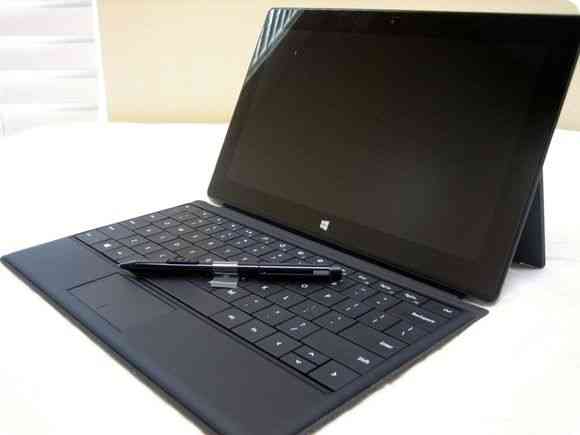
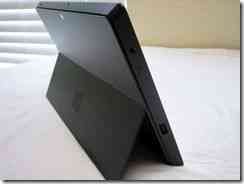
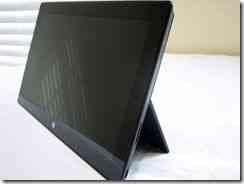










I think the Surface Pro is a beautiful machine, but I do have some concerns, especially about running it as a laptop.
1. How is battery life at full screen brightness and full CPU performance?
2. How does the keyboard feel to type large chunks of text, compared to other laptops?
3. Is the screen too small for use side-by-side applications, even with the high resolution?
Wouldn’t other devices, such as the Samsung Ativ SmartPC Pro 700T, the Lenovo ThinkPad Helix or the Asus Transformer Book be better alternatives, since they have a real keyboard attached to the screen, and more battery life?
Isn’t Surface Pro too much of a compromise?
1. I haven’t run a test under those conditions, it would obviously be less than under optimal power saving settings and what you are actually using on the tablet. I will give that a go and let you know.
2. The keyboard takes some getting used to, and is probably suited to those with smaller hands but its good enough for my smaller hands to work on for a full page of a Word doc, for example. A regular laptop keyboard with larger keys and better key travel will be better but I use this as my primary machine and I don’t find myself going for my old laptop or desktop,
3. The screen is only 10.6″ so you need to have good eyesight! But it still works fine with two windows snapped side by side on the desktop at the default 150% scaling. Going any lower on the scaling will probably be quite a strain for most people.
Ultimately, its going to be down to the individual what device suits them best. The Surface Pro has the advantage of portability over the devices you mention, with its lower size and weight. For some the increased size of the keyboards, screens in those devices will make them a better choice. Battery life may be the sticking point but the ease with which you can carry the Surface Pro around and have access to a full laptop’s power is probably its biggest plus point.
Whether the Surface Pro is too much of a compromise is a decision that will vary by different individuals and their needs but it will definitely be ideal for some people.
I can add something here.
Full backlight will add 1W drain so expect about 10-15% less battery life under full brightness when web browsing.
As for full CPU, the Ivy Bridge CPUs can range up quite high. If you’re rendering video in CPU, for example, you could half your battery life. An extreme example is gaming where, on every device built with the Ultrabooks platform, you’ll be looking at 25W drain. On the surface Pro that would be under 2hrs battery life!
The other extreme is that the Surface Pro could reach 8hrs battery life with offline word processing.
Hope that helps.
Chippy.
I hear you on compromise, but seems this is less of a compromise than anything else. A standard laptop is too much of a compromise for me. The weight of the power cord alone is too much. When’s the last time anyone walked around with a laptop open walking and working? iOS and Android tablets are too much of compromise. Most the stuff I want to do I can’t get done.
This is getting real close to what many of us want, with some nuance issues. Personally I’m not sure I want to wait for Haswell for the battery life. This looks pretty good as a primary PC, secondary mobile device. If you want that flipped there are Atom Tablets. Battery there is amazing
This sort of battery life is simply unacceptable for a mobile device. It’s actually an insult to consumers to bring something like this to market and expect them to be satisfied. I’d rather have a core i3 and some extra heft but have a minimum on 6,5 hours of battery life, without having to sacrifice performance. What’s the point of having a state-of-the-art processor if you have to throttle it to 25 percent of its capabilities? Just pathetic.
I’ve been a staunch MS supporter, but this sort of product mismanagement seriously pisses me off. No wonder Surface sales across the board are floundering. Why waste time on Windows RT instead of optimizing W8 for Atom processors?
RT is stillborn and will die soon. Unbelievable incompetence.
A Core i3 isn’t going to bring you any more battery life when you want to get computing tasks completed.
The Surface Pro is truly the best possible product with the current technology right now.
Keep watching for Haswell though because battery life reports will be totally different. We’ll be reporting double-figure battery life for Core i7 devices stating in July, I can guarantee it.
Chippy.
I hope Haswell is truly the quantum leap that’s desperately needed nowadays. In an era where mobile computing is the new paradigm, the constraints of battery stamina are just ghastly.
If Haswell does deliver double-figures battery life, it’s frankly a new dawn for mobile computing, and a well overdue one. And, I suppose, next-gen Atom platforms will also see extended endurance when it comes to battery stamina – although I’m not sure if it’ll be a tick or tock in Intel’s road plan.
I have only been using the Surface Pro for the last 6 days and really enjoying the built quality and performance. I thought I would miss the battery life that I was getting on the ATIV 500, W510 and ASUS Vivo Tab Smart but really have been able to go through out the day with no problems.
Like Chippy said, Haswell will give us at least twice the battery life a iCore processor.
Atom does get lot better battery life. Some similar or even better than RT. Just check out some of the reviews like the ThinkPad 2 and the Dell Latitude 10. So maybe that’s whay you are looking for.
I’m not aware of any mobile device at this size under 2 pounds with core CPU that gets 7+ hours of battery life. Probably by end of year we see next gen (but that’s all Intel, not Microsoft’s schedule).
Actually there is a 10.1 tablet, Kupa X15 to be made available sometime in April. I planned on waiting for that one to become available but based on this review and what actual owners say about the Surface Pro I went ahead and ordered it from the Microsoft online store.
“This sort of battery life is simply unacceptable for a mobile device. ”
Perhaps that’s because it’s not really intended as pure mobile device but rather a portable device that can be used mobile.
MS specifically chose the 10.6″ screen size as a compromise between mobile and portable size ranges.
Really, the size and weight is not optimal for single handed use. You actually need two hands for comfortable usage and the keyboard cover is best used on a table like a improvised laptop.
While, as Chippy stated, this is about the best they can do with present technology. We’ll see how Haswell improves what’s possible…
“What’s the point of having a state-of-the-art processor if you have to throttle it to 25 percent of its capabilities?”
The better question is whether you actually need 100% performance all the time?
Mobile devices generally don’t need much performance for most of the things done with them!
So most of the things you would be using a lot of resources for would also usually require you to be stationary and focus on working with the system.
Really, throttling performance for better mobility is nothing new to PC’s. It’s just been mainly either/or up till now and it’s actually a improvement that it can be scaled as needed.
So, for most people, the purpose of this sort of device is to have performance when you need it but still able to be mobile enough to get around for longer than a few minutes.
While those who really need performance will also likely not need to use the device as a tablet all the time and would thus be better off with a hybrid or similar solution.
“Why waste time on Windows RT instead of optimizing W8 for Atom processors?”
Windows 8 works fine with ATOM processors, there’s a whole bunch of Clover Trail Windows 8 tablets already!
The point of RT was for a mobile/tablet optimized version of Windows and basically compete with other mobile OS like iOS… It’s also why they chose the iPad to base the price range for the Surface RT…
Optimizing W8 for Atom would obviously mean somewhat stripping it down, while still providing backward app compatibility, which is what people want. Even though it works on Atom, app startup times, for instance, are not optimal, but could possibly be optimized.
RT is dead on the water. Samsung basically sealed it when refusing to market RT devices in the US. It’ll prove another gigantic waste of time, money and resources.
WiDi?
No WiDi, Microsoft used a Marvell chip instead of Intel.
Microsoft Surface Pro is the best compute I ever purchased in my life with no regret. 2 pounds, rear camera is very useful for my classes, type cover is great, performance…I LOVE everything about this device. Also, the only Windows with magnetic charger.
At first, I was concerned about the battery life, but it actually 4-5 hours was good enough. Plus the power adapter is light and plugs are available everywhere. Don’t believe all of the bias review this device is awesome.